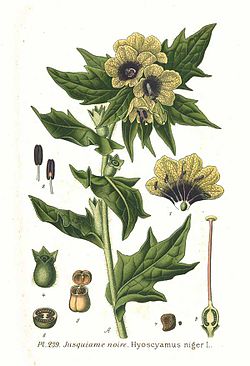Hyoscyamus niger (botany): Difference between revisions
>David Hedlund italic in lead |
>JohntheCaptain expansion of the history section and the creation of a new section |
||
| (12 intermediate revisions by 4 users not shown) | |||
| Line 4: | Line 4: | ||
==Chemistry== | ==Chemistry== | ||
The leaves and herbage contain S-(–)-hyoscyamine and S-(–)-scopolamine. Trace amounts of aposcopolamine, not scopolamine, littorine, tropine, cuscohygrine, tigloidine, and tigloyloxytropane have also been found.<ref> | The leaves and herbage contain S-(–)-hyoscyamine and S-(–)-scopolamine. Trace amounts of aposcopolamine, not scopolamine, littorine, tropine, cuscohygrine, tigloidine, and tigloyloxytropane have also been found.<ref>{{cite book | vauthors=((Rätsch, C.)) | date= 2005 | title=The encyclopedia of psychoactive plants: ethnopharmacology and its applications | publisher=Park Street Press | isbn=9780892819782}}</ref> | ||
==History== | |||
In the play Macbeth, by Shakespeare, when Banquo and Macbeth just had the encounter with the three witches, Banquo says in act 1 scene 3, (after encountering the witches and hearing their prophecies, Banquo wonders if they have been hallucinating. He says:<ref>Macbeth, Act 1, scene 3</ref> | |||
{{Quote|Were such things here as we do speak about? Or have we eaten on the insane root that takes the reason prisoner?}} | |||
In this quote, the, "Insane Root" refers to '''Hyocyamus niger''', as '''Hyocyamus niger''' was gaining popularity in Europe in the time of Shakespeare.<ref>{{Citation|title=Macbeth Glossary - Or have we eaten on the insane root|url=https://www.shakespeare-online.com/plays/macbeth/macbethglossary/macbeth1_1/macbethglos_insaneroot.html}}</ref> | |||
Henbane was allegedly used by the witches of the Medieval/Middle Ages, probably as a flying ointment, and was proven to be one after Dr. Erich-Will Peuckert of the University of Gottingen, together with a colleague, attempted a formula for a witches 'flying' potion that had henbane along with other plants as an ingredient to prove that the plants listed in the formula would make one sleep into a trance-like state:<ref>Devereux, P. (2008). The Long Trip: A Prehistory of Psychedelia, page 103. Australia: Daily Grail Publishing.</ref> | |||
{{Quote|We had wild dreams. Faces danced before my eyes which were at first terrible. Then I suddenly had the sensation of flying for miles through the air. The flight was repeatedly interrupted by great falls. Finally, in the last phase, an image of an orgiastic feast with grotesque sensual excess.}} | |||
== Toxicity and harm potential == | |||
It is an anticholinergic poison and has been responsible for a multiple amount of cases that involved the poisoning of people from the plant.<ref>{{Citation|title=Common anticholinergic solanaceaous plants of temperate Europe - A review of intoxications from the literature (1966–2018)|url=https://www.sciencedirect.com/science/article/abs/pii/S0041010120300362}}</ref> | |||
==External links== | ==External links== | ||
* [[wikipedia:Hyoscyamus niger|''Hyoscyamus niger'' (Wikipedia)]] | |||
* [https://erowid.org/plants/henbane/henbane.shtml Henbane (Erowid Vault)] | *[[wikipedia:Hyoscyamus niger|''Hyoscyamus niger'' (Wikipedia)]] | ||
*[https://erowid.org/plants/henbane/henbane.shtml Henbane (Erowid Vault)] | |||
==References== | ==References== | ||
<references/> | <references /> | ||
[[Category:Solanaceae (family)]] | [[Category:Solanaceae (family)]] | ||
[[Category:Deliriant | [[Category:Deliriant plant]] | ||
Latest revision as of 15:29, 12 July 2025

Hyoscyamus niger is known to cause dangerous and extremely unpleasant experiences.
Please use responsible use practices when trying this drug and always have a trip sitter.
| Hyoscyamus niger (botany) | |
|---|---|
 Drawing of H. niger |
|
| Taxonomical nomenclature | |
| Kingdom | Plantae |
| Unranked | Angiosperms |
| Unranked | Eudicots |
| Unranked | Asterids |
| Order | Solanales |
| Family | Solanaceae |
| Genus | Hyoscyamus |
| Species | H. niger |
| Common nomenclature | |
| Common names | Henbane, Stinking nightshade |
| Constituents | |
| Active constituents | Tropane alkaloids |
Hyoscyamus niger, commonly known as henbane, black henbane, or stinking nightshade, is a deliriant plant in the family Solanaceae.
Chemistry
The leaves and herbage contain S-(–)-hyoscyamine and S-(–)-scopolamine. Trace amounts of aposcopolamine, not scopolamine, littorine, tropine, cuscohygrine, tigloidine, and tigloyloxytropane have also been found.[1]
History
In the play Macbeth, by Shakespeare, when Banquo and Macbeth just had the encounter with the three witches, Banquo says in act 1 scene 3, (after encountering the witches and hearing their prophecies, Banquo wonders if they have been hallucinating. He says:[2]
Were such things here as we do speak about? Or have we eaten on the insane root that takes the reason prisoner?
In this quote, the, "Insane Root" refers to Hyocyamus niger, as Hyocyamus niger was gaining popularity in Europe in the time of Shakespeare.[3]
Henbane was allegedly used by the witches of the Medieval/Middle Ages, probably as a flying ointment, and was proven to be one after Dr. Erich-Will Peuckert of the University of Gottingen, together with a colleague, attempted a formula for a witches 'flying' potion that had henbane along with other plants as an ingredient to prove that the plants listed in the formula would make one sleep into a trance-like state:[4]
We had wild dreams. Faces danced before my eyes which were at first terrible. Then I suddenly had the sensation of flying for miles through the air. The flight was repeatedly interrupted by great falls. Finally, in the last phase, an image of an orgiastic feast with grotesque sensual excess.
Toxicity and harm potential
It is an anticholinergic poison and has been responsible for a multiple amount of cases that involved the poisoning of people from the plant.[5]
External links
References
- ↑ Rätsch, C. (2005). The encyclopedia of psychoactive plants: ethnopharmacology and its applications. Park Street Press. ISBN 9780892819782.
- ↑ Macbeth, Act 1, scene 3
- ↑ Macbeth Glossary - Or have we eaten on the insane root
- ↑ Devereux, P. (2008). The Long Trip: A Prehistory of Psychedelia, page 103. Australia: Daily Grail Publishing.
- ↑ Common anticholinergic solanaceaous plants of temperate Europe - A review of intoxications from the literature (1966–2018)